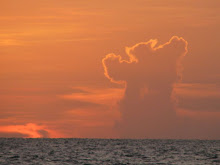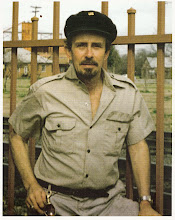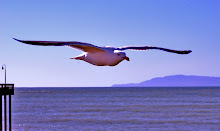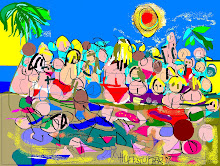The first of a set dedicated to the memories of San Diego in the early 1960s. Watercolor pencils with brush washes and some pen and ink details.
LIBERTY IN SAN DIEGO 1960S STYLE By Robert L. Huffstutter
When I got out of USNTC Boot Camp in 1960, I received orders to COMNAVAIRPAC across the bay at NAS North Island. It was a great duty station, working for the flag officers and Naval Air matters. At that time, there was no Coronado bridge and the only way to get downtown was via the nickel snatcher, a USN boat that went from NAS to the foot of Broadway. The walk up to the center of San Diego to Union Square was an experience with the various tattoo parlors, cafes and beer joints. The drinking age, however, was strictly 21, and most of the clubs enforced this with no exceptions. But there were some place off Broadway that would bend the rules. The bar above was not one of them. The old bar named Pearl's Harbor was strictly for the old vets who were in World War II, so that was not a hangout for us young guys. At the time, many of the guys who were in WWII were still on active duty and finishing up 20 years of service. Wow, time flys. When I think of being in the service at the same time the guys who won the war were in the service it blows my mind. Anyway, that was the way it was in 1960, and it was a different America back then. The coffee tasted different, the hot roast beef sandwiches were richer and thicker and nobody was worried about how much fat we consumed.
There was no major racial strife--most all the guys got along well; it mattered little about color or religion then. Despite the tales that might be spun by the left, there was equal treatment and equal opportunity in the USN in the 60s.
So, that's the way it was in the summer of 1960 around Pearl's Harbor. The beer smelled good drifting through the door, but all of us who were not 21 had to find a lesser establishment to buy our draft beer for 20 cents a mug. Bottles were about 35 cents. When we finished up the night, we walked back down to the foot of Broadway and caught the nickel snatcher, a little craft that was a bit bigger than an admiral's boat, and headed back to the Naval Air Station, eating our cupcakes and drinking our coffee or pop, hoping we wouldn't stumble getting off the boat. That was a liberty in downtown San Diego, 1960s style.
Friday, June 4, 2010
Wednesday, March 17, 2010
Tuesday, February 23, 2010
DETAILS OF: HOT DOGGIES, A WATERCOLOR
AN ESSAY ON WATERCOLORS BY ROBERT L. HUFFSTUTTER
If there's one major truth about painting with watercolors, it is the sense the artist has that the painting is either not "quite right" or "not quite" done, two sensations that can totally ruin what could have been a fairly decent watercolor.
These two personal assessments are not restricted to the zany or psychotic artist, they are absolutely normal whether one is a Sunday painter or commercial artist. How do I know? Simple, I have been around long enough to know these facts through personal experience and through conversation with other artists. Moreover, observation is the evidence that supports these opinions. What can we do to minimize our cost of expensive French watercolor paper and increase our confidence and self-esteem?
The answer is as primary as a a set of Prang watercolor paints. Remove the painting and set it aside for several weeks. Look at it after the time lapse and ask yourself several questions. Should there be more black lines around the window sills? Do you really need to make the blonde's hair longer? And how about the biceps of the men showing off--should they be more pronounced and obvious? Should there be two more palm trees down by the beach? After pondering over these superficial dilemmas, one will usually decide that enough is enough.
Now, about the part that there's something about the work that is "not quite right." That, unfortunately, is the realization and admission that only a few people can paint like Don Kingman. If we are so naive or vain that we do not want to exhibit until we perfect our art to the heights that Kingman's art has reached, we might as well put the brushes and paints out in the garage and wait for a neighborhood sale.We must believe that although we are not as professional and prolific as artists like Kingman, we must accept our style as our own and learn to appreciate it as our contribution to the very large and sometimes hollow world of art. To continue our momentum and keep our spirits positive, we need to keep painting as many subjects and scenes as possible. Sooner or later, we will accept ourselves as being the best we can be and understand our style is unique.
We might even begin to really appreciate our work and feel a warm fondness and affection for our paintings in much the same manner as we appreciate the work of our favorite artists. There is nothing to prevent us from looking at Kingman's magnificent watercolors and hoping that in time, we will feel like we are getting better with the completion of each new and different watercolor. That is, I honestly believe, what Don Kingman believed each time he finished a painting. One fact is obvious, he knew when to sign his name to signify that it was done.
WATERCOLORS THAT ARE NOT QUITE RIGHT AND NOT QUITE DONE BY ROBERT L. HUFFSTUTTER
If there's one major truth about painting with watercolors, it is the sense the artist has that the painting is either not "quite right" or "not quite" done, two sensations that can totally ruin what could have been a fairly decent watercolor.
These two personal assessments are not restricted to the zany or psychotic artist, they are absolutely normal whether one is a Sunday painter or commercial artist. How do I know? Simple, I have been around long enough to know these facts through personal experience and through conversation with other artists. Moreover, observation is the evidence that supports these opinions. What can we do to minimize our cost of expensive French watercolor paper and increase our confidence and self-esteem?
The answer is as primary as a a set of Prang watercolor paints. Remove the painting and set it aside for several weeks. Look at it after the time lapse and ask yourself several questions. Should there be more black lines around the window sills? Do you really need to make the blonde's hair longer? And how about the biceps of the men showing off--should they be more pronounced and obvious? Should there be two more palm trees down by the beach? After pondering over these superficial dilemmas, one will usually decide that enough is enough.
Now, about the part that there's something about the work that is "not quite right." That, unfortunately, is the realization and admission that only a few people can paint like Don Kingman. If we are so naive or vain that we do not want to exhibit until we perfect our art to the heights that Kingman's art has reached, we might as well put the brushes and paints out in the garage and wait for a neighborhood sale.We must believe that although we are not as professional and prolific as artists like Kingman, we must accept our style as our own and learn to appreciate it as our contribution to the very large and sometimes hollow world of art. To continue our momentum and keep our spirits positive, we need to keep painting as many subjects and scenes as possible. Sooner or later, we will accept ourselves as being the best we can be and understand our style is unique.
We might even begin to really appreciate our work and feel a warm fondness and affection for our paintings in much the same manner as we appreciate the work of our favorite artists. There is nothing to prevent us from looking at Kingman's magnificent watercolors and hoping that in time, we will feel like we are getting better with the completion of each new and different watercolor. That is, I honestly believe, what Don Kingman believed each time he finished a painting. One fact is obvious, he knew when to sign his name to signify that it was done.
WATERCOLORS THAT ARE NOT QUITE RIGHT AND NOT QUITE DONE BY ROBERT L. HUFFSTUTTER
Subscribe to:
Posts (Atom)













